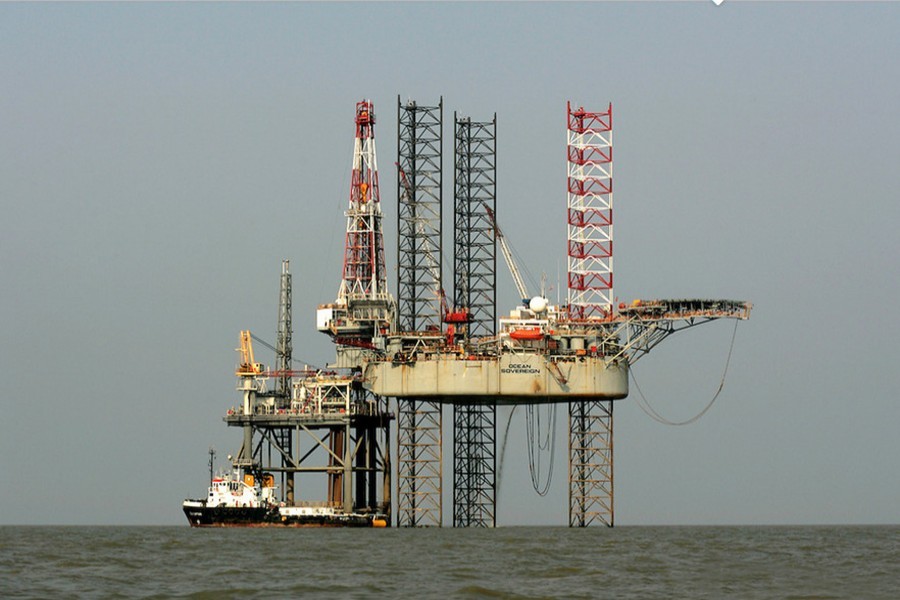The country's maiden offshore natural gas platform Sangu has remained abandoned over the past seven years, posing a threat of permanent damage to the facility worth millions of dollars.
Petrobangla, the owner of the platform, is yet to decide on its use either by state entities or by private entrepreneurs, said a senior Petrobangla official.
But industry insiders say multiple international firms are expecting this platform mainly as a gateway to import LNG (liquefied natural gas), regasify and supply it through the Sangu facility.
Sangu facilities include the platform in the Bay of Bengal, subsea pipeline and onshore gas process plant.
The onshore gas process plant is located at Fouzdarhat in south-eastern Chattogram district.
A 50-kilometre-long 20-inch diameter seabed pipeline was also built between the offshore platform and the onshore plant.
Sangu platform is located at calm sea near the planned bay terminal of Chattogram port at Silimpur, which is free from sea turmoil.
Unlike the country's two operational FSRUs (floating, storage, regasification unit), sources say, it has the advantage to be functional even during peak monsoon season without interruption.
Earlier, LNG regasification at Excelerate Energy's and Summit Group's FSRUs at Moheshkhali island in the Bay of Bengal was disrupted several times due to rough sea.
Officials said energy and mineral resources division made a move several years ago to build or install a small-scale FSRU to regasify around 200 million cubic feet per day (mmcfd) of LNG by a global firm.
Vitol Asia was in final talks with the state-run Petrobangla and its subsidiary, Rupantarita Prakritik Gas Company Ltd, to build a mini FSRU at Sangu platform and supply around 200 mmcfd of regasified LNG.
But the plan was shelved in 2018 as the government focused more on building bigger-capacity FSRUs and subsequently built two units having the capacity to regasify around 500 mmcfd each.
To meet the mounting gas demand, the government now considers allowing private entrepreneurs to build more FSRUs, regasify imported LNG and supply it to national gas grid, said a senior energy ministry official.
When contacted, energy expert Prof Ijaz Hossain, who teaches at Bangladesh University of Engineering and Technology, seeks urgent government action to use Sangu platform with its subsea pipeline before its damage.
"As millions of dollars were invested there, the government can allow an interested firm to install an FSRU and supply regasified LNG to end-users through the existing pipeline with the platform."
Sangu gas field was discovered in 1996 in the Bay of Bengal, 50 kilometres off the land near Silimpur.
Australian oil and gas firm Santos was in charge of operations when the field was permanently shut on 01 October 2013.
Sources said Sangu started supplying gas in 1998 under the operatorship of Cairn Energy.
Initially, it produced around 50 mmcfd of gas, which increased up to 180 mmcfd.
Production levels dropped to an average 49 mmcfd in 2009 and 18 mmcfd in 2011.
It was declared abandoned when gas production dropped to 2.0-3.0 mmcfd at the end of 2013.
According to Petrobangla, an estimated 488 billion cubic feet (Bcf) of gas was produced from this gas field from 1998 to 2013.
Sangu was discovered by Cairn with a proven reserve of 800 Bcf. Its ownership was handed to Dutch Shell Oil Company with assets and liabilities in 1998.
But after steady production of gas for six years from Sangu, Shell gave all of its upstream assets and undertakings back to Cairn in 2004.Cairn sold the field to Santos in 2010.
Santos and its predecessors Cairn and Shell invested more than $1.0 billion in Sangu gas field.


